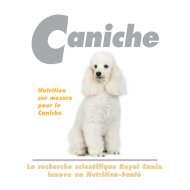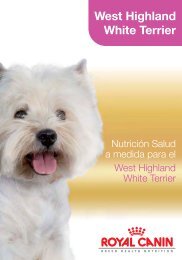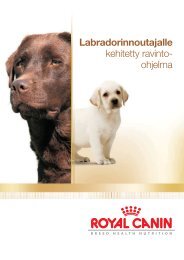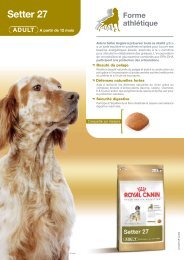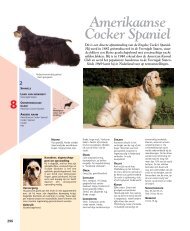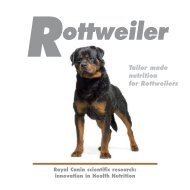Create successful ePaper yourself
Turn your PDF publications into a flip-book with our unique Google optimized e-Paper software.
Chronic energy overconsumption predisposes the subject to obesity to a higher degree when it is<br />
started at an early age. Overconsumption in the puppy stimulates the multiplication of adipose cells,<br />
which stock fat in the adult body. Limiting the fat content is particularly important for sedentary and<br />
neutered dogs. If the Cocker has a very active lifestyle (e.g. as a gundog), a food with a higher fat<br />
content may be advisable.<br />
A low kibble density to<br />
ensure the feeding volume<br />
is sufficient<br />
While limiting the fat content avoids the feeding<br />
amount being reduced to an unacceptable<br />
level, it is important not to feed the dog<br />
too high a volume too. The key is to observe<br />
the recommended feeding guide, adapting it<br />
as the dog’s weight develops. To help ensure<br />
the dog accepts the feeding amount as satisfactory<br />
– who can resist a begging Cocker?<br />
– it is a good idea to try to ensure the dog is<br />
satiated. That is why the density of Cocker<br />
25 kibbles is so low. At the same weight of<br />
food, the volume is greater than that of a<br />
standard food.<br />
Achieving satiety with<br />
psyllium<br />
"Recommended ration for a 26-lbs Cocker<br />
(1 hour of activity per day)"<br />
Cocker 25 contains the husk of psyllium* seeds. The fibre in this husk – mucilage – helps trap<br />
water, forming a gel in the stomach. The envelope of psyllium seeds contains 25-30% mucilage.<br />
Psyllium seeds have traditionally been used for their appetite-suppressing qualities. They<br />
slow down the rate at which the stomach is emptied, giving the dog the feeling that it<br />
has eaten its fill. Psyllium also has positive effects on digestive transit, regulating<br />
the movement of intestinal content and facilitating the elimination of stools.<br />
200<br />
150<br />
100<br />
50<br />
150<br />
100<br />
50<br />
200<br />
17<br />
With<br />
Cocker 25<br />
150<br />
100<br />
50<br />
0 0<br />
200 mL<br />
180 mL<br />
200<br />
200 mL<br />
580 mL<br />
of Cocker 25<br />
kibbles<br />
With a standard food,<br />
higher density<br />
200<br />
150<br />
100<br />
50<br />
0 0<br />
200 mL<br />
When the energy concentration is the same, the particular shape<br />
of Cocker 25 kibbles means that a larger volume of the food can be<br />
served even when the weight of the ration is reduced.<br />
150<br />
100<br />
50<br />
200<br />
75 mL<br />
150<br />
100<br />
50<br />
200<br />
200 mL<br />
475 mL<br />
of standard<br />
food



